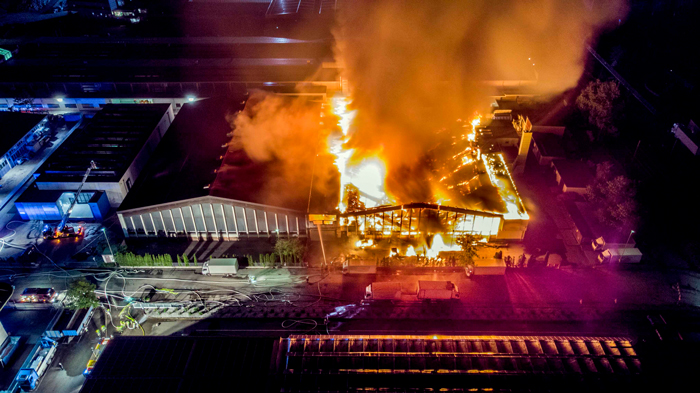Three Major Fires In 24 Hours: At A Time Of Covid-19 Are We Forgetting How Destructive Fires Can Be?
 logo.png) With three large building fires in 24 hours, the impact and devastation caused by fire continues to remind us just how vulnerable to fire so many buildings are with the consequences far-reaching. The Covid-19 crisis may well dominate our minds and is the top of the agenda for businesses wanting to get back to work, but as they return to work the vulnerabilities to fire are exposed. It rightly challenges us to ask: why are so many companies vulnerable to such large fires with largely unprotected building stocks?
With three large building fires in 24 hours, the impact and devastation caused by fire continues to remind us just how vulnerable to fire so many buildings are with the consequences far-reaching. The Covid-19 crisis may well dominate our minds and is the top of the agenda for businesses wanting to get back to work, but as they return to work the vulnerabilities to fire are exposed. It rightly challenges us to ask: why are so many companies vulnerable to such large fires with largely unprotected building stocks?
On Saturday 30th May, a fire engulfed several buildings owned by an award-winning, family-run crisp manufacturer with a £10 million annual turnover and one of Cambridgeshire’s most respected community-minded companies. The blaze at Corkers near Ely saw the entire complex ravaged by fire in only two hours, sending smoke plumes which could be seen as far away as Bedford and closing local roads. Up to 60 firefighters from three counties fought to contain the blaze which Paul Clarke group commander of Cambridge Fire and Rescue said was “a very serious fire involving industrial units.” Employing 80 workers, Corkers Crisps founder Ross Taylor said: “I am shell shocked, devastated… there are generations of work all just gone.”
In Burnley, one day earlier, a fire ripped through another family-run business, Equestrian Surfaces, which provides materials for surfacing arenas and schools for horse-riding. While the 40m x 20m building will remain standing due to the structure remaining intact, the company lost machinery and equipment valued at around £500K according to the owners. Sixty firefighters across Lancashire tackled the blaze which sent large plumes of smoke drifting across large residential areas. Residents were advised to stay at home and keep windows and doors shut due to the harmful smoke.
On the same day, a fire in north-west London destroyed an industrial unit owned by a kitchen furnishings company and damaged an adjacent industrial unit. Fifteen appliances and 125 firefighters battled the blaze at Azco Interiors in Park Royal which sent huge plumes of acrid black smoke into the sky. Once again, the impact on this and adjacent businesses will be huge due to loss of stock and rebuild costs.
Sadly, we have seen similar events repeated across the UK including in the Merseyside area. A large blaze on an industrial estate in Newton-le-Willows was one of three fires in the area in three days. It was declared a major incident and involved 20 fire engines and, like the events above, required resources from neighbouring fire and rescue services. This prompted Merseyside Fire and Rescue to call for a greater “focus on business safety”.
So, as we asked earlier, why are such buildings not subdivided or provided with more forms of fire protection? Put simply, this is not required by our current Building Regulations. However, businesses often consider that approval under the regulations means their premises are protected. It does not: the regulations protect life, not property. Given the challenges, it is surely time to consider the wider impact of fires within the community and the benefits of property protection.
Commenting on these fires, Iain Cox, Chair of the Business Sprinkler Alliance said: “Currently and understandably the news headlines continue to be about coronavirus. However, fire is still a threat and as these examples demonstrate, it happens on a regular basis. The impact of a blaze is usually much wider than anticipated. Whilst insurance will cover some costs, there are other costs that cannot be recuperated. And at time when people are finding the economy at its lowest ebb, losing livelihoods and jobs is something we should surely be avoiding.”
To prevent similar scenarios from occurring there needs to be more joined-up thinking on items like property protection. This also needs to be coupled with education on the minimum outcomes delivered by regulations. At the same time, there is a need for conscious business resilience decision-making for realistic action for businesses to safeguard themselves from fire’s devastating effects. The events above all demonstrate, that unless trading can continue quickly, businesses feel the financial pressure of maintaining cash flow and often flounder. Fire is indiscriminate and inexplicable, but that doesn’t mean actions can’t be taken to control it when it occurs.
Preventing large costly fires is possible through a combination of strategies. One of the most effective strategies is the use of sprinkler systems which control, contain and control fires before the Fire and Rescue Service arrive. They therefore minimise the wider impact of unmanageable fires, reducing costs to business and the economy as a whole. Importantly, by limiting any fire damage, they allow business to resume operations quickly, often within hours of the incident.
Given the availability of solutions, it begs the question as to why do we continue to repeat the same actions over and over again and expect the same results? We need to break the chain and have the discussion on property protection for the benefit of our wider communities, the environment, longer-term business security, and the mutual benefits it will bring.
For more information about the BSA visit: www.business-sprinkler-alliance.org























































